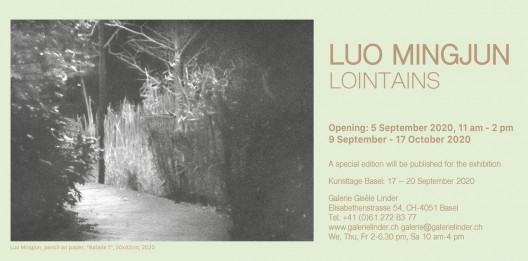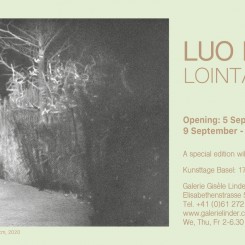Luo Mingjun assigns multiple meanings to the word “distance” (lointains) – the theme of this exhibition at the Galerie Gisèle Linder.
On the one hand, it refers to our current shared experience of the protective measures to combat Covid-19: lockdown at home and/or the closing of borders. Without a spatial, geographical “somewhere else”, the distant has become a nostalgic dream for many and can even become bound up with the hope for a better (albeit utopian) life.
On the other hand, distance in a temporal sense is a central element in Luo’s Mingjun work. The artist has lived in Switzerland since 1987 and, in her search for her own identity, she links her Chinese origins with her European present. However, her relationship to her roots proves to be something distant, vague, like faded images rising out of her memory. When she emigrated, the artist had incidentally also lost her Chinese citizenship on account of Chinese legislation.

These two facets of the distant shine permeate the exhibited works.
In a very large-format picture, Mingjun Luo has taken up a theme she has already dealt with in her work: the magnolia, a tree in her garden which she can see from her studio window. However, she has brought the customarily empty background to life with an ethereal, imaginary atmosphere of the distant. This distance is like an echo from a “somewhere else” that is currently unreachable.
The magnolia itself is additionally a part of the artist’s search for identity. Not only does the tree accompany her in her current everyday life: it is also of Asian origin, as she discovered by chance. She pursues her search for identity in the heart of the form of her artistic expression, which she uses to link her present with her past. In this context she has adopted the technique of Western oil painting, but she nonetheless employs it in keeping with certain principles of Far Eastern ink painting: in her oil painting she generally limits herself to grey tones, playing with light and shadow, abundance and emptiness – the empty canvas is active and appears in the form of the strongest shadow.
In two small paintings, the magnolia becomes a pure network of twigs and dabs of light, a response to the tracery of a screened window that emerges in dark on light, lit from behind. This type of window was common in Ancient China as well as other cultures. It made it possible to see out without being seen. At that time, it pointed to a feeling of simultaneous security and danger, just like that unleashed by the Covid-19 lockdown today.
Among many other works, the misty-airy image of an airport conjures up a journey to a distant land. The barely identifiable contours of the aeroplanes and the strange light somewhere between day and night are shrouded in secrecy. A secret that permeates many of Luo’s Mingjun works. It can also be found in the watercolour of a series: the artist uses dabs – goutelettes d’eau (drops of water), as the title says – to suggest a few fleeting traces of her origins with the help of an old family photo.
In these hints between presence and absence, Mingjun Luo leaves her works open to her viewers’ fantasy. She interprets the meaning of the signs in her way, something, almost nothing, which is anchored in the Chinese tradition. The entirety of her art, by the way, pursues the secret and an opening. This is also shown by how she selects the details for her images – the magnolia of which she has recorded only fragments, a single cloud on an empty canvas – or, above all, the interplay she creates between abundance and emptiness, light and shadow, the material of the colour and the empty canvas.
